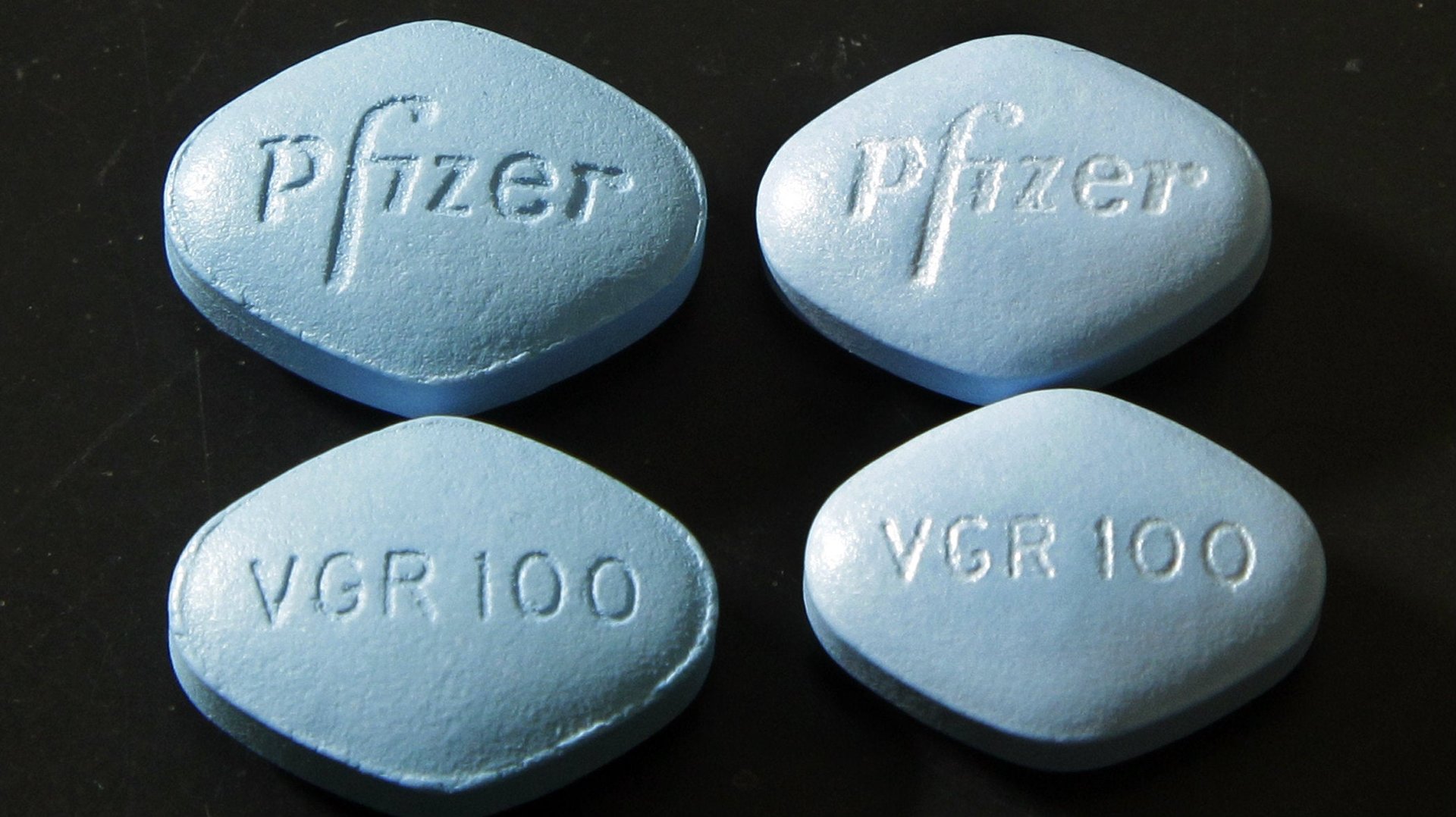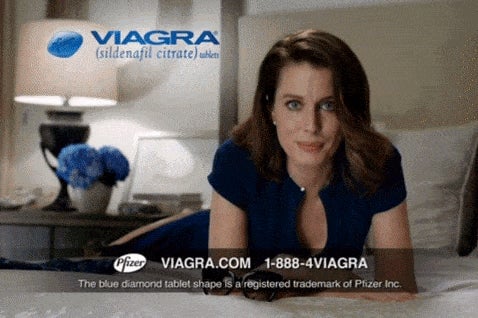After 20 years, Viagra has impacted so much more than just sex
On this day in 1998, the US Food and Drug Administration approved a chemical compound called sildenafil citrate for use as a prescription drug for erectile dysfunction, which, at the time, wasn’t even a recognized medical condition.


On this day in 1998, the US Food and Drug Administration approved a chemical compound called sildenafil citrate for use as a prescription drug for erectile dysfunction, which, at the time, wasn’t even a recognized medical condition.
The researchers who discovered Viagra weren’t even looking for it. Sildenafil, the drug’s active ingredient, was originally developed to treat cardiovascular problems—specifically to dilate the heart’s blood vessels by blocking a particular protein called PDE-5. But early clinical trials were a bust, and by 1993, Pfizer was considering abandoning the project. That is, until they noticed the men enrolled in the study did something weird whenever the nurses went to check on them.
“They found a lot of the men were lying on their stomachs,” John LaMattina, who was the head of research and development at Pfizer while this research was ongoing, told the STAT Signal Podcast (listen in around 7:15). “A very observant nurse reported this, saying the men were embarrassed [because] they were getting erections.” The blood vessels were dilating, but not in the heart, but rather the penis.
Thus was born Viagra.
“We were rock stars”
In 1996, Pfizer patented the compound, and in just two years, the pharma giant was able to push its little blue pill through the wringer of clinical trials the government requires to call a medication safe and effective. Most drugs take about a decade.
Viagra was a rousing success from the moment it came on the market. In the few weeks following FDA approval, some 40,000 prescriptions were written. A year later, Viagra served as a plot point on HBO’s Sex and the City on its way to becoming the fastest drug ever to surpass $1 billion in annual sales.
“We were rock stars,” Pfizer salesman Jamie Reidy told Bloomberg. “Never before, and probably never again, will anybody get a standing ovation in the waiting room.”
Viagra’s rapid growth in popularity had a buoying effect on the growth of entire pharmaceutical industry. Of course, that sort of rapid growth couldn’t…well…last.
That said, Viagra did have numerous long-term impacts on the pharmaceutical industry. One of those was in pharma advertising.
Viva Viagra!
Pfizer’s drug hit the market just a year after US regulators eased up on the rules regarding direct-to-consumer drug advertising. Then in 2003, the FDA approved Cialis and Levitra, two new ED drugs to compete with Viagra, ushering in a decade when it was nearly impossible to avoid commercials for drugs promising to improve the sex life of middle-aged men.
This Cialis commercial is a perfect example of what basically every ED drug advertisement tries to do: to be sexy without actually talking about sex. These TV ads have historically gotten a lot of play during programming, like football games, that invite a lot of family viewers—so the commercials need to be PG. Even though the bathtubs don’t really make any sense, at this point they’re iconic.
Many ED drug commercials have reached similar levels of cultural iconicity. There’s definitely no forgetting Pfizer’s “Viva Viagra!” campaign of the mid-2000s, while Levitra was introduced to the world in 2003 on a TV spot centering on a legendarily bad metaphor for sex.
Ads for Viagra and its competitors have evolved over the years. In the beginning, the ads centered around potential Viagra users (including the occasional “We are the Champions” slo-mo montage). But soon, a new template emerged, as The Cut’s Gabriella Paiella explained:
The vast majority of Viagra ads feature a polished woman in her 40s with long, straight hair gazing seductively at the camera and saying things like “Hey, you, let’s fix your penis” in dulcet tones … You know the pose: Her stomach’s on the mattress, she’s resting on her elbows, and her feet might be kicked up in the air. It’s the “We need to talk about your boner” pose.

Where’s the female Viagra?
Sexual dysfunction drugs tend to focus on the penis, which makes up at most only half, and sometimes none, of the horizontal tango. Pharmaceutical companies have tried and failed to find and market a female Viagra equivalent.
Pfizer tried to use Viagra to treat “female sexual arousal disorder” in the early 2000s—one critic called it “a textbook case of disease mongering by the pharmaceutical industry”—but clinical trials were inconclusive and the efforts were scrapped.
In October 2015, Sprout pharmaceuticals got clearance from the FDA to start selling Addyi, which reportedly increased women’s libido. Unfortunately, it was a flop—doctors had written only 4,000 prescriptions for it by the following April.
Why? For one thing, unlike Viagra, Addyi, the pill needed to be taken daily, as opposed to when a woman was planning on having sex—yet each pill cost the same as a dose of Viagra. Additionally, physicians had to be “certified” to prescribe Addyi. (it was just a 10-minute online course, but…doctors.) And finally, Addyi only worked “modestly,” even for women who took it daily as recommended.
“The recent history of the study of female sexual dysfunction is a classic example of starting with some preconceived, and non-evidence based diagnostic categorisation for women’s sexual dysfunctions, based on the male model, and then requiring further research to be based on that structure,” John Bancroft, director of the Kinsey Institute at Indiana University, told the medical journal BMJ. “Increasingly it is becoming evident that women’s sexual problems are not usefully conceptualised in that way.”
Could Viagra save your life?
Probably not, but a trip to the doctor for an ED prescription just might. There are a variety of underlying causes of ED and most have to do with the circulatory system. (Some notable exceptions are psychological issues and direct injuries.) If blood isn’t flowing well to the penis, chances are it’s not flowing well elsewhere in the body, and ED can be an early warning sign for much bigger issues, heart disease in particular. The Mayo Clinic recommends that men without any obvious cause for ED should be screened for underlying heart problems, and Dr. Michael P. O’Leary told the Harvard Health blog that erections “serve as a barometer for overall health.”
Pfizer explicitly tapped into this dynamic when it began marketing the drug. “We had to give physicians a reason to have a conversation about this,” Ken Begasse, formerly of the Viagra ad agency Cline Davis & Mann, told the trade magazine Medical Marketing & Media. “That meant linking [erectile dysfunction] to the things physicians were traditionally concerned about — diabetes and cardiac conditions in particular. In so many words, it was pretty much, ‘Hey, doc, you should be asking about erectile dysfunction, because it often happens 18 months before a cardiac event.’”
The twilight of Viagra today
As generic ED drugs have begun to eat into its market share, Viagra is no longer the powerhouse it once was. Annual sales of Viagra peaked at $2.05 billion in 2012; in 2020, Pfizer’s patent on Viagra is set to expire.
That’s led Pfizer to pull out of what used to be Viagra’s biggest media moments. After years of being the National Football League’s biggest pharmaceutical advertiser, Viagra bought no commercial time whatsoever during the 2017-2018 season. Cialis is expected to follow suit. (Levitra stopped advertising during football games in 2011.)
That’s not to say ED meds are no longer popular. Far from it, in fact. The Pharmaceutical Security Institute, a nonprofit industry organization, estimates that 37% of all counterfeit drugs seized are marketed as ED cures, and as recently as 2015, the UK government seized $15.6 million worth of unlicensed ED pills.
That same year, local authorities in southern China busted distillers for adding the impotence drug Viagra to their products. Officials seized more than 5,300 bottles of baiju, a clear, grain-based spirit that is the country’s most popular hard liquor, along with large quantities of sildenafil, the generic name for the drug. The suppliers reportedly told customers that the liquor had “health preserving qualities” and was made with “Chinese herbs.”
Later that year, purportedly “organic” orange juice S Lion that was billed as “suitable for the entire family” in Singapore actually turned out to have significant levels of erectile dysfunction drugs. Some of the S Lion Juice products, sold online, contained tadalafil, the active ingredient in Cialis, a prescription drug for erectile dysfunction, while other drinks have chemical compounds related to sildenafil, the generic name for Viagra, according to Singapore’s Health Sciences Authority (HSA).
Prescription numbers continue to rise, and there are pretty clear signs ED drugs are more than here to stay: There are now apps that let you buy generic pills online, whose marketing is specifically targeting millennials.
Viagra by the digits
- 6: The number of prescriptions you had to fill to on your Viagra frequent-user “value card” in order to get a free seventh script in 2004
- 62 million: number of men who take the little blue pill globally, according to Pfizer
- $15: cost of an individual Viagra pill in 1998 (adjusted for inflation)
- $65: cost of a single Viagra pill today
- $1.2 billion: Viagra revenues in 2017
- $359 million: Estimated amount of revenue Viagra will generate in 2018